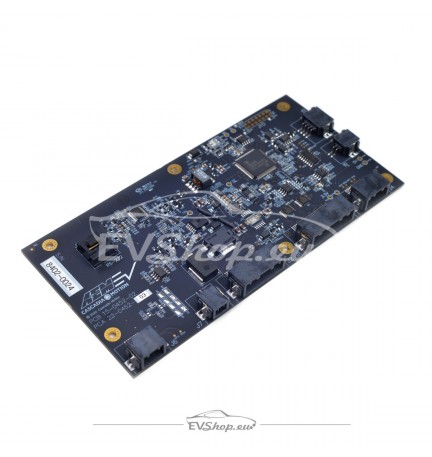AEM Tesla Model S/X Motor Controller Logic Board for Use with VCU200
AEM EV is releasing a comprehensive controls system for EV conversions using a Tesla Base Large Drive Unit (LDU) that significantly increases horsepower over the factory output. The Inverter Control Board (PN 30-8402) in AEM EV’s system was co-developed with Cascadia Motion, an industry leader in EV propulsion systems, to ensure the highest standards of quality and reliability. It combines with AEM EV’s VCU200 vehicle control unit (PN 30-8000) to deliver OE-level safety, full vehicle control and increased power. AEM EV’s VCU200 and Inverter Control Board combo eliminates the uncertainty and limitations of CAN-Spoofing control, and hobby-level capabilities of Open-Source alternatives. It delivers more power and full control through a thoroughly validated system.
AEM Tesla Model S/X Motor Controller Logic Board for Use with VCU200
Using the same electrical current during testing, AEM EV was able to increase the Tesla LDU Base Drive’s horsepower by 26% over the baseline horsepower as measured on the company’s chassis dynamometer. AEM EV believes further increases in output power are possible before the system is released. Final output horsepower gains will be announced upon the LDU Inverter Control Board product release, which is scheduled for mid Q1 of this year. Validation for the Tesla LDU Performance Drive motor is scheduled for later this year.
Complete Control, Maximum Performance and Safety for LDU EV Conversions
AEM EV’s LDU Base Drive Inverter Control Board replaces the OEM Tesla board in the LDU inverter and connects to the VCU200 over CAN bus. An adapter harness is included with the Inverter Control Board that provides a near plug & play connection except for sourcing 12V power and ground connections. The AEM EV VCU200/LDU Inverter Control Board system is designed for EV conversions; it will not operate an LDU-equipped OEM Tesla vehicle.
The LDU Inverter Control Board for the Tesla LDU and the VCU200 must be used together to achieve the reported power gains and to use the additional control and safety features that the VCU200 provides, including the features listed below:
• Motor torque management (programmable torque curves) dependent on vehicle operating states and other driver-selectable modes
• Dynamic torque limits for traction/launch control strategies maximize safety and optimize performance
• Input characterization including accelerator pedal, brake switch, PRND switches, and other driver/vehicle inputs
• Accessory control of cooling pumps, cooling fans, lights and more
• Redundancy and arbitration features for all safety-critical inputs
• Startup and shutdown sequencing of high voltage components, including independent contactor control
• CAN message translation for BMS, inverter, PDUs, and other CAN accessories
• Diagnostics and fault detection including CAN message timeouts, thermal limits, contactor, and inverter enable cross-checks
• Intuitive Software
AEMcal software for AEM EV VCUs simplifies the process of customizing the power delivery strategies and controlling all the ancillary subsystems of EV motorsports and conversion vehicles. AEMcal software is free to download from our website and it is fully enabled (not a demo version), allowing users to explore its full suite of features and capabilities.
Utilizing a simplified and intuitive graphical interface that combines tables and graphs for implementing strategies for torque delivery, launch control (stationary and dynamic), traction control, regenerative braking, speed limiting, map switching, and more, AEMcal software puts an end to the need for stacking multiple controllers to control an EV's propulsion and ancillary systems. AEMcal software is available for download on the Software page.



